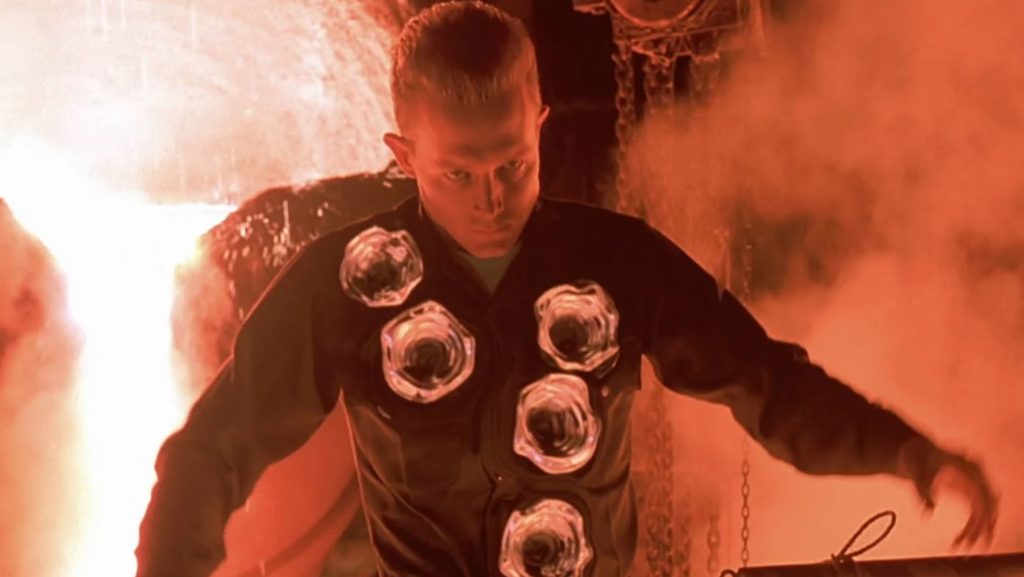 By Elias Marat
By Elias Marat
Researchers for the U.S. Army are hoping to formulate a new shape-shifting material that can heal itself on its own in hopes to achieve the kind of futuristic killing technology famously depicted in the 1991 science-fiction film, Terminator 2.
In fact, the film’s villain, the T-1000, directly provided the inspiration to one of the Army engineers working on a project to develop “soft robotic” drones and unmanned aircraft based on flexible, self-repairing and self-reconfiguring materials, reports Military.com.
“We want a system of materials to simultaneously provide structure, sensing and response,” said Frank Gardea, an aerospace engineer at the Army Combat Capabilities Development Command’s (CCDC) Army Research Laboratory.
Gardea hopes that the U.S. military will soon have future platforms for air and ground combat that possesses the “reconfiguration characteristics of the T-1000 character in the Hollywood film, ‘Terminator 2,’” he said in an Army statement.
In the blockbuster film, the T-1000 created by Skynet is described as being an “advanced prototype” made of a “mimetic pollyalloy” or “liquid metal.” The villainous cyborg portrayed by actor Robert Patrick was able to transform its arms into sword-like stabbing weapons and self-heal after sustaining various types of wounds ranging from pistol shots to 12-guage shotgun blasts and even a direct hit from a 40mm grenade launcher.
Gardea’s team, which worked alongside scientists at Texas A&M University, is hoping to develop a new epoxy material capable of “massive reconfigurability,” the ability to heal autonomously in the air or underwater, and embedded intelligence that would grant it the ability to adapt to its environment free of any direct external control.
Become an Activist Post Patron for $1 per month at Patreon.
.@USArmy researchers and our Texas A&M University partners explore self-healing materials https://t.co/AYJddNMLBn This material has a dynamic bond that allows it to go from liquid to solid multiple times, which allows it to be 3-D printed and recycled. @armyfutures @usarmyccdc pic.twitter.com/ZEIUv89JuP
— U.S. Army CCDC Army Research Laboratory (@ArmyResearchLab) August 17, 2020
Fortunately, the team working out of the U.S. Army’s Aberdeen Proving Ground facility in Maryland hasn’t yet devised the sort of unstoppable killing machine depicted in the Terminator series – however, they have developed a 3D-printed, flexible polymer with a “unique shape memory behavior” that can be programmed to remember and snap back to certain shapes, and can even be repeatedly melted down and reused.
“Most cross-linked materials, especially those that are 3D printed, tend to have a fixed form, meaning that, once you manufacture your part, the material cannot be reprocessed or melted,” Gardea explained, adding that the material has a “dynamic bond that allows it to go from liquid to solid multiple times, which allows it to be 3D printed and recycled.”
Gardea says that the development provides “a first step along a very long path toward realizing the scientific possibility for deep future platforms.”
This isn’t the first time that U.S. military technologists have compared their developments to the artificial intelligence-equipped cyborgs depicted in James Cameron’s Terminator series starring Arnold Schwarzenegger, which revolved around time-traveling military robots that “can’t be reasoned with [and] doesn’t feel pity, or remorse, or fear,” as one character in the original film says.
'An Army engineer working on soft robotics says that his work is directly inspired by the T-1000, the shape-shifting (and fictional) robot villain from the 1991 James Cameron blockbuster “Terminator 2.”'
Look, not all ideas are good ideas. #NoFatehttps://t.co/z8BelxEAoJ
— Sarah O'Connor (@Sara_Lisabeth) August 20, 2020
The U.S. Navy has worked on developing a 135-ton autonomous unmanned surface vehicle (USV) named the Sea Hunter, which would provide an autonomous platform for anti-submarine and electronic warfare as well as serving as a decoy in any live-fire clash involving human forces.
The prospect of AI-guided warfare has alarmed critics, who believe that an overreliance on computerized and autonomous weapons on the battlefield poses the risk of leaving complex ethical choices about who lives or dies in the hands of algorithms, rather than humans.
The Campaign to Stop Killer Robots has been at the forefront of these concerns, raising concerns over how autonomous weapon systems “would decide who lives and dies, without further human intervention, which crosses a moral threshold,” according to its website.
Last year, former top Google engineer Laura Nolan told the Guardian that she had joined the Campaign to Stop Killer Robots because the robot systems envisioned by Big Tech firms and militaries could potentially do “calamitous things that they were not originally programmed for.”
Source: The Mind Unleashed
Subscribe to Activist Post for truth, peace, and freedom news. Send resources to the front lines of peace and freedom HERE! Follow us on SoMee, HIVE, Parler, Flote, Minds, and Twitter.
Provide, Protect and Profit from what’s coming! Get a free issue of Counter Markets today.
US Army Researchers Creating Robot Tech Directly Inspired by T-1000 Villain from “Terminator 2”